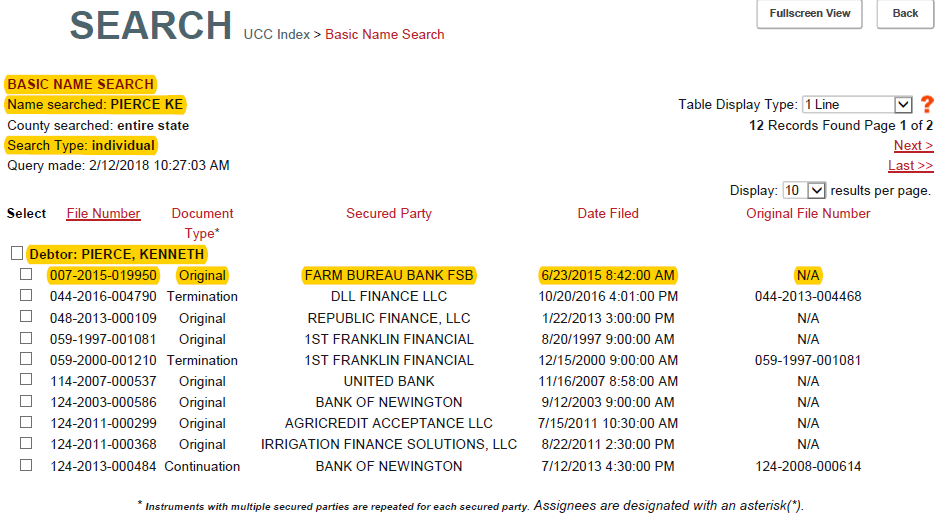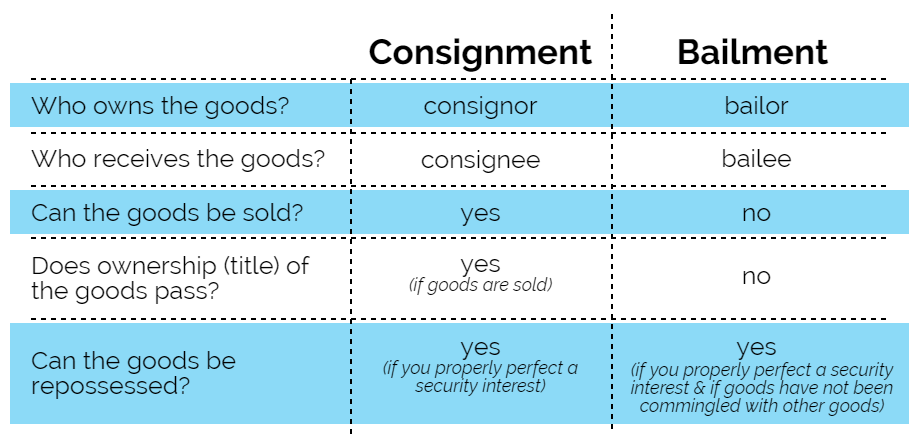
Filing a UCC on an Individual? Make Sure You Comply with UCC Article 9-503
To Determine Whether One Creditor Correctly Identified the Individual on the UCC Filing, a Bankruptcy Court Had to Venture into Uncharted UCC Article 9 Territory
Filing a UCC on an individual? It is critical that you comply with Article § 9-503(a): The Financing Statement must list the debtor’s name as it appears on the debtor’s unexpired driver’s license.
Let me repeat: The Financing Statement must list the debtor’s name as it appears on the debtor’s unexpired driver’s license.
But what happens if the printed name on the driver’s license is different than the individual’s signature on the driver’s license? Technically, both names (the printed & signed) appear on the license – which is correct?
Until now, no one has questioned whether the name shown in the signature or the printed name on the driver’s license should appear on the Financing Statement. This is uncharted territory under UCC Article 9.
Of course, we’ve encountered cases where the name on the Financing Statement and driver’s license don’t match, but these differences are typically due to spelling errors. Errors such as a misspelled last name: the name on the driver’s license is ”Susan Walker” vs. the name on the Financing Statement is ”Susan Wakler”. We’ve even encountered a case where the name on the driver’s license was misspelled, and the courts determined the misspelling should have been reflected on the Financing Statement.
But an argument that compliance with Article § 9-503 is achieved when using the driver’s license signature vs. the printed name? Definitely a new layer of complexity.
In a recent bankruptcy case, one Georgia court determined the printed name on the unexpired driver’s license is the name that should appear on the UCC Financing Statement, leaving one creditor’s security interest unperfected.
The Case | Bank Lends Money, Debtor Files for Bankruptcy Protection
In 2015, Kenneth R. Pierce (Pierce) obtained an $18,000 loan from Farm Bureau Bank (Bank) and the proceeds of the loan were used to purchase farming equipment, a fertilizer spreader. Bank and Pierce executed a security agreement and Bank filed a UCC to perfect its security interest.
In 2017, Pierce filed for Chapter 12 bankruptcy protection. Subsequently, Bank timely filed a proof of claim for the balance owed of $14,459.81 and attached a copy of their UCC-1 to the proof of claim.
On the UCC filing, Bank identified Pierce as “Kenneth Pierce;” however, Pierce’s name on his unexpired driver’s license was “Kenneth Ray Pierce.” Pierce filed an objection with the Bankruptcy Court, claiming Bank’s security interest was unperfected, because Bank incorrectly identified Pierce on the UCC filing.
Quick Refresher on “Alternative A”
Before we get into the Court’s review of the case, let’s do a quick review of Alternative A under the 2010 UCC Amendments.
In compliance with § 9-503(a), when the debtor is a registered organization, creditors should rely on the information found on the public organic record.
If the debtor is an individual, creditors must first look to the state’s legislation. With the 2010 Amendments, each state had to decide whether they would implement “Alternative A” or “Alternative B.”
Alternative A: if the debtor holds an unexpired driver’s license, the Financing Statement must list the debtor’s name as it appears on the unexpired driver’s license. (If the debtor does not have a driver’s license, the Financing Statement should list the “individual name” of the debtor or the debtor’s surname and first personal name.)
Alternative B: the debtor’s driver’s license name, the debtor’s actual name or the debtor’s surname and first personal name may be used on the Financing Statement.
The Bankruptcy Court’s Review | Technically Two Names Appear on the Individual’s Driver’s License
Technically two names appear on Pierce’s driver’s license, at least that is Bank’s primary argument. See, the printed name on his driver’s license is “Kenneth Ray Pierce” though Pierce’s signature reads “Kenneth Pierce.” Bank argued that Article § 9-503(a) doesn’t specify whether the identifying name must be the name that is typed on the driver’s license.
“But as Farm Bureau Bank points out, there are two names “indicated on the driver’s license”: “Kenneth Ray Pierce” (typed) and “Kenneth Pierce” (signed). Farm Bureau Bank argues that O.C.G.A. § 11-9-503(a)(4) is not limited to the name typed on the driver’s license, but rather that it includes the name signed by the Debtor, and thus its Financing Statement does provide the (signed) name of the Debtor.”
Georgia is an Alternative A state, and in the plain text of the law, Bank isn’t necessarily wrong; it does not specify whether the printed name or signed name is the name to be listed on the Financing Statement:
9-503. NAME OF DEBTOR AND SECURED PARTY.
(a) [Sufficiency of debtor’s name.]
[Alternative A]
(4) subject to subsection (g), if the debtor is an individual to whom this State has issued a [driver’s license] that has not expired, only if the financing statement provides the name of the individual which is indicated on the [driver’s license];
(5) if the debtor is an individual to whom paragraph (4) does not apply, only if the financing statement provides the individual name of the debtor or the surname and first personal name of the debtor;
Thus, it becomes the Court’s duty to determine whether the error on the Financing Statement is seriously misleading, or if Bank’s security interest is perfected because it substantially complied with the law.
The Bankruptcy Court’s Review | Webster’s Dictionary, Case Law & Basic Compliance with the Law
Courts weigh a variety of factors when deciding a case, often relying on previous legal decisions for guidance, the “plain language of the law” and even Webster’s dictionary.
The Court thought perhaps the answer would lie within the definition of “indicate” as it appears in “indicated on the driver’s license.”
“Turning to Webster’s Third New International Dictionary 1150 (1981) the following are among the definitions provided for the word “indicate”: “to point out or point to or toward with more or less exactness,” to “show or make known with a fair degree of certainty,” and to “reveal in a fairly clear way.” These definitions do not help the Court determine which of two names is “indicated” on the Debtor’s driver’s license. Indeed, the presence of two different names on the driver’s license is precisely the opposite of exactness, certainty, and clarity.”
I now understand the saying “clear as mud.”
The Court also reviewed various Georgia cases. Unfortunately, most of the cases did not address the exact issue in this case. The Court then turned to other jurisdictions’ case law, and one Nebraska bankruptcy case shed some light, though the case was decided prior to the 2010 Amendments and does not wholly apply to the case at hand.
“In Genoa Nat’l Bank v. Southwest Implement, Inc. (In re Borden), the debtor was identified by his legal name “Michael Ray Borden” or by “Michael R. Borden” on his driver’s license and on other legal documents. 353 B.R. 886, 887-88 (Bankr. D. Neb. 2006). However, the debtor often signed legal documents by his nickname, “Mike Borden.” Id. The court held that financing statements identifying the debtor as “Mike Borden” were seriously misleading. Id. at 892. In re Borden suggests that the name typed on legal documents trumps the name signed by the debtor.”
OK, What about Standard Search Logic?
The second argument Bank lodged was that the UCC would appear in a search based on Georgia’s standard search logic. But, under that argument, the search would have been done using Pierce’s name on his driver’s license – “Kenneth Ray Pierce.” And, a search for “Kenneth Ray Pierce” would not have uncovered the filing for “Kenneth Pierce.”
As a side note, a search of Georgia’s UCC Index can be done with a partial name. Yes, Bank should have searched by the individual’s name as it appears on the driver’s license, however, a partial search of “Pierce, KE” revealed the UCC:

Seriously Misleading, Unsecured Status
On its Financing Statement, Bank failed to identify its debtor in compliance with § 9-503. Failing to correctly identify its debtor meant the UCC filing would not be uncovered in a search. The Court declared Bank’s UCC as seriously misleading, bumping Bank to unsecured creditor status.
Always Obtain a Copy of the Driver’s License
At NCS, our UCC experts continually stress the importance of the driver’s license, yet nearly 30% of creditors fail to comply with Article 9 requirements. I know, you are tasked with a lot and it’s easy to overlook or neglect the driver’s license. But the name on the driver’s license, the printed name, is vital for a perfected security interest.
This case is another example of a creditor losing its secured status because of an avoidable error. Don’t jeopardize your perfected security interest; obtain a copy of the unexpired driver’s license as a part of your credit application process. Every. Time.




